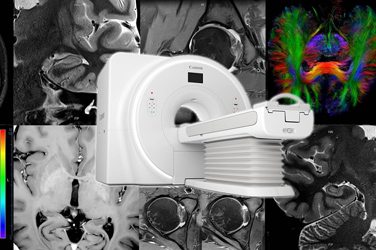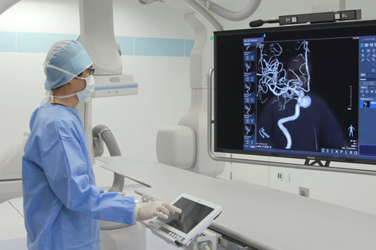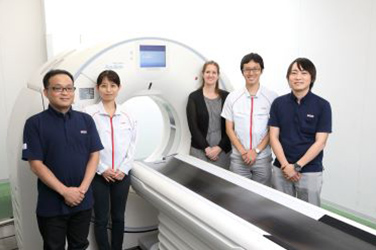Technology in ProductsMRI Scanners
Systems that Perform Imaging Using Magnetic Fields
and Radio Waves without X-ray Exposure to Patients
MRI scanners obtain cross-sectional images of the human body using radio waves and magnetic fields generated by powerful magnets. There is no X-ray exposure, so they can even be used to safely perform examinations of young children. Canon's diagnostic imaging technologies, hidden in the ring-shaped bodies of these scanners, assist with early diagnosis of diseases.
March 17, 2022

How MRI Scanners Work
MRI scanners comprise five principle components: a superconducting magnet that generates a powerful magnetic field, high-frequency coils that transmit radio waves, gradient coils that alter the magnetic field, receiver coils that catch the radio signals from the patient's body, and a patient table, which places the patient inside the donut-shaped scanner. MRI scanners use magnetic fields, radio waves, and the fact that approximately 70% of the human body is made up of water, which contains hydrogen nuclei, to freely perform vertical, horizontal, and diagonal cross-section imaging of the human body.
Read More
Canon Technologies Used in MRI Scanners
Pianissimo™ Acoustic Noise Reduction Technology
While MRI scanners have the advantage of not requiring X-ray exposure, they also have drawbacks, such as long scan times, the need to use contrast agent, and acoustic noise. To reduce the burden on patients and medical personnel, Canon has been at the forefront of advancing MRI scanner technology to perform MRI imaging faster, more reliably, and more comfortably. Standard MRI testing produces a great deal of acoustic noise, which can make patients uncomfortable or scared. This acoustic noise is caused by the current flowing through the gradient coils inside the large magnet. When this current flows, force is generated in accordance with Fleming's left-hand rule, which causes the gradient coils to vibrate. These vibrations are then conveyed to parts such as the magnet itself and cause the equipment itself to generate acoustic noise. However, with Pianissimo™ , Canon Medical's acoustic noise reduction technology, the gradient coils are vacuum-sealed to reduce the acoustic noise propagation by 90% compared to conventional Canon Medical MRI scanners. This makes examinations quieter and reduces the burden imposed on patients.

How the vibrations that produce acoustic noise are generated

Development of a Vacuum Chamber to Seal Off the Gradient coil
World 1st Deep Learning Reconstruction for MR
It takes about 20 to 30 min for MR examination generally. Particularly cardiac examination, it takes up to one hour. Long examination time imposes a burden on the patients. In addition, it is difficult to increase the number of examination per day in hospital, so that patients need to wait several days until their reservation.
Canon MR Advanced intelligent Clear-IQ Engine (AiCE) based on AI technology realizes short examination time for patient and hospital.
AiCE removes noise and obtain high quality images with short time by using deep learning.

New Receiver Coil for Patient Comfort

Shape coil is a flexible, versatile and comfortable receiving coil for MR imaging.
So far, the use of a dedicated receiving coil designed for each body parts has been the mainstream.
However, there are restrictions on setting them depending on the size and condition of the patient's body. In addition, it is hard-shape and patients could not take the examination comfortably when patients have some pain.
On the other hand, Shape Coil has a very flexible-shape like a blanket. It improves the quality of imaging while maintaining patient comfort without restrictions depending on the imaging.
Shape Coil is a comfortable item designed with the patient undergoing the examination in mind.

Non-contrast MRA Makes It Possible to Perform Blood Vessel Imaging without Using Contrast Agent
Non-contrast MR Angiography (MRA) makes it possible to perform imaging of blood vessels using an MRI scanner, without the use of a contrast agent. Using a contrast agent to observe blood vessels produces clear images, but can also cause side effects including nausea, malaise, and headaches. Canon took the lead in developing non-contrast MRA applications, beginning its development efforts in the 1990s. Since 2006, Canon has incorporated the Time-Spatial Labeling Inversion Pulse (Time-SLIP) non-contrast examination system in all of its MRI scanner models. This system images only the blood vessels you wish to observe. The ability to perform imaging without the use of contrast agent has made it possible for imaging to be used on even more patients.

Renal artery (left) and portal vein (right) selectively imaged using the Time-SLIP technique
Marketing Authorization/Notification No.
Generic Name | Brand name | Marketing Authorization No. | Manufacturer/ Distributor |
|---|---|---|---|
Superconducting magnet type whole-body MR device | Vantage Titan MRT-1510 | 227ADBZX00010000 | Canon Medical Systems Co. |
Superconducting magnet type whole-body MR device | Vantage Orian MRT-1550 | 230ADBZX00021000 | Canon Medical Systems Co. |
Superconducting magnet type whole-body MR device | Vantage Elan MRT-2020 | 225ADBZX00170000 | Canon Medical Systems Co. |
Superconducting magnet type whole-body MR device | Vantage Galan 3T MRT-3020 | 228ADBZX00066000 | Canon Medical Systems Co. |






